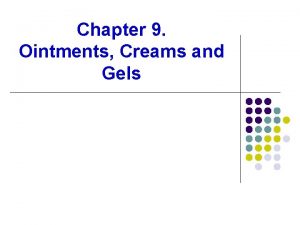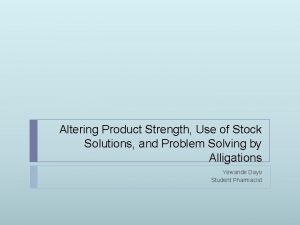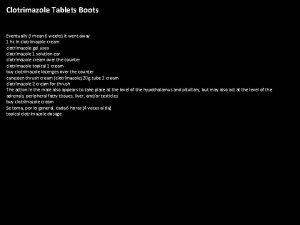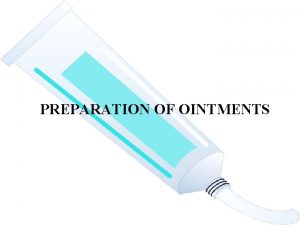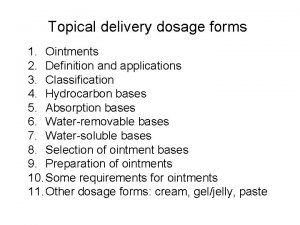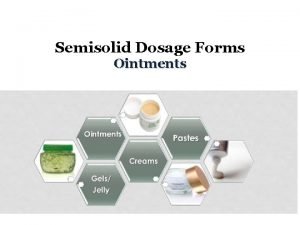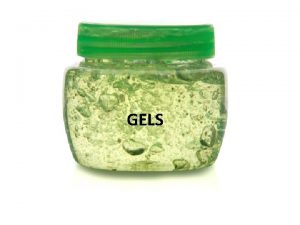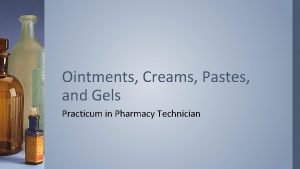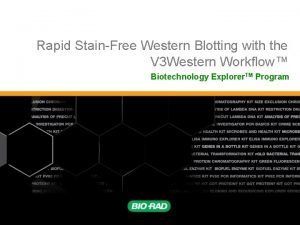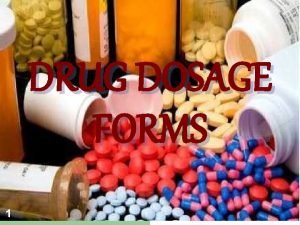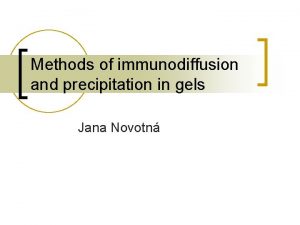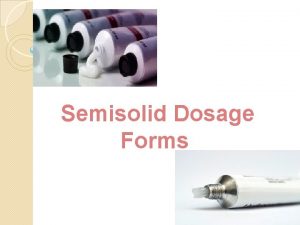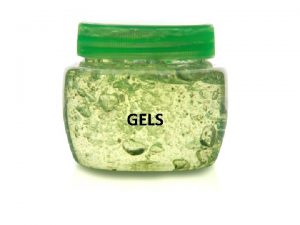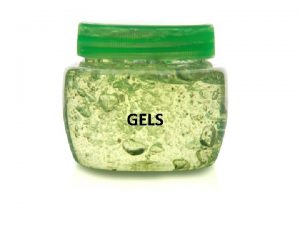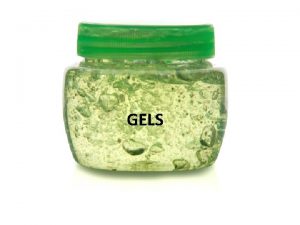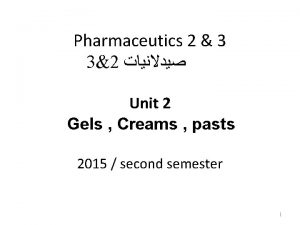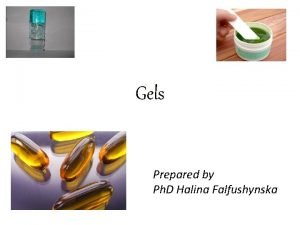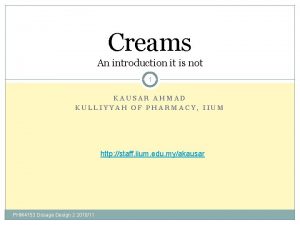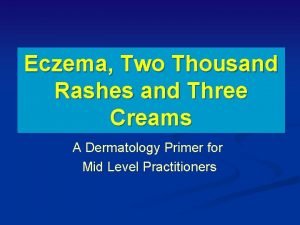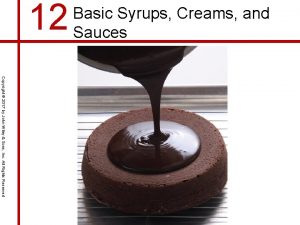Ointments Creams and Gels Dr J Domenech INTRODUCTION























- Slides: 23

Ointments, Creams, and Gels Dr. J. Domenech

INTRODUCTION Topicals • Preparations applied to the skin either for their physical effects or for the specific effect of a medicinal agent • Protectants, lubricants, emollients, drying agents, astringents Transdermals • Designed to support the passage of drug substances from the surface of the skin, through its various layers, and even into the systemic circulation

INTRODUCTION Functions of Dermatologicals • Protect injured areas from the environment • Provide for skin hydration (emollient) • Vehicle for medication transport Drug Penetration Is Dependent Upon: • Amount of pressure and vigor of rubbing • Surface area covered • Condition of the skin • Base used • Occlusive dressing use Application Areas for Dermatologicals LOTIONS Intertriginous areas CREAMS Moist, weeping lesions OINTMENTS Dry, scaly lesions

Ointments • Semisolid preparations intended for external application to the skin or mucous membranes. • Semisolid plastic flow characteristics • Definite yield value • Resistance to flow drops as application continues

Ointments Ointment Bases Preparation of Ointments • Oleaginous Bases • Absorption Bases • Water-Removable Bases • Water-Soluble Bases • Incorporation • Fusion Compendial Requirements for Ointments • Microbial Content • Minimum Fill • Packaging, Storage, and Labeling • Additional Standards

Ointments Oleaginous Bases • Water insoluble • Not water washable • Can’t absorb water • Oily, occlusive, lack cosmetic appeal Examples: • Hydrocarbons (mineral oils, petrolatums, paraffins, waxes) • Animal fats/vegetable oils (castor oil, cottonseed oil, olive oil) • Synthetic esters (glyceryl monostearate, butyl stearate, isopropyl lanolate, stearyl alcohol) • WHITE PETROLATUM • WHITE OINTMENT Absorption Bases • Water insoluble • Not water washable • Can absorb water • Anhydrous • Oily, occlusive, lacks cosmetic appeal Examples: • Hydrophilic petrolatum • Aquaphor • Aquabase

Ointments Emulsion Base Water-in-Oil • Water insoluble • Not water washable • Can absorb water • Contains water Emulsion Bases Oil-in-Water • Water insoluble • Water washable • Can absorb water • Contains water Examples: • Cold Cream (Petrolatum-Rose Water Ointment) • Lanolin • Nivea • Eucerin Examples: • Hydrophilic Ointment • Velvachol • Unibase • Dermabase • Vanicream • Acid Mantle

Ointments Humectants • Glycerin • Propylene glycol • Sorbitol 70% Water-Soluble Bases • Water soluble • Water washable • Can absorb water • Anhydrous or hydrous • All water soluble, no oil phase Example: • Polyethylene Glycol Ointment • Biozyme Ointment, Desenex Ointment, Whitfields Ointment • Veegum 10% Dermatological base • Veegum 5% Thixotropic lotion

Ointments Selection of the Appropriate Base • Release rate • Topical or percutaneous drug absorption • Occlusion • Stability of drug • Effect of drug on ointment base • Easily removable? • Characteristics of surface for application Ointment Preparation • Ointment Slab/Pill Tile • Mortar/Pestle • Ointment Mill • Fusion üHeat highest melting point material first üWater phase a few degrees higher üW/O: add water slowly üO/W: add oil slowly Incorporation • Mortar and pestle • Pill tile and spatula • Ointment mill • Unguator • Incorporation of solids • Incorporation of liquid

Ointments Ointment Packaging • Jars: Glass, Plastic üDo not pour in while hot! • Disp. Jars: Plastic • Tubes: Plastic, tin, aluminum • Syringes: Individually dosed, good protection of the product Labeling and Storage • Labeling üProtect with tape üDual labels üCreativity often required • Storage üStore in a cool place

Creams • Opaque, soft solids, or thick liquids intended for external application. • Semisolid, pseudoplastic flow • Very little yield value • Won’t flow under force of gravity but small force will initiate flow • Viscous liquids or semisolid emulsions of either the O/W type or the W/O type • Term “cream” is most frequently applied to soft, cosmetically acceptable types of preparations.

Gels • Semisolid systems consisting of dispersions of small or large molecules in an aqueous liquid vehicle rendered jelly-like through the addition of a gelling agent • A semirigid system in which the movement of the dispersing medium is restricted by an interlacing network of particles or solvated macromolecules of the dispersed phase

Gels Types of Gels • Single Phase üGels in which the macromolecules are uniformly distributed throughout a liquid with no apparent boundaries between the dispersed macromolecules and the liquid üUsually involve organics • Two Phase üWhen the gel mass consists of floccules of small distinct particles üUsually involve inorganics

Gels Gel Composition • Gelling agent • Water • Cosolvents • Preservatives • Stabilizers Kinds of Gels Gelation • As a hot, colloidal dispersion of gelatin cools, the gelatin macromolecules lose kinetic energy. • With a reduction of kinetic energy or thermal agitation. • Gelatin, agar, pectin, Irish moss, pectin, tragacanth form gels by this mechanism. • Hydrogels üSilica, bentonite, pectin, sodium alginate, methylcellulose, alumina • Organic Gels üContain an organic liquid (e. g. , Plastibase) • Carbomer Gels üAqueous dispersion neutralized with sodium hydroxide or triethanolamine • Methylcellulose Gels • Starch Glycerite • Aluminum Hydroxide Gel

Gels Phenomena Associated with Gels • Syneresis - When the interaction between particles of the dispersed phase becomes so great that on standing, the dispersing medium is squeezed out in droplets and the gel shrinks • Swelling -The taking up of liquid by a gel with an increase in volume • Imbibition - The taking up of a certain amount of liquid without a measurable increase in volume • Thixotropy -A reversible gel-sol formation with no change in volume or temperature • Jelene/Plastibase - A combination of mineral oils and heavy hydrocarbon waxes with a MW of about 1300 • Carbomer 934 - A polymer of acrylic acid cross-linked with a polyfunctional agent; recognized as an official emulsifying and suspending agent

Gels Applications • Oral • Topical • Intranasal • Vaginal • Rectal Gelling Agents • Alginic acid • Bentonite • Carbomer • CMC Sod • Colloidal Silicon Dioxide • Veegum • Methylcellulose • Plastibase/Jelene • Poloxamer/Pluronic • Povidone • Propylene Glycol Alginate • Sodium Alginate • Tragacanth

Quality Control • Appearance • Uniformity • Weight/Volume • Viscosity • Clarity • p. H • Others Packaging/Storage/Labeling Stability • Physical Stability - Shrinkage - Separation of liquid from the gel - Discoloration • Microbial Stability • BUD: Unless otherwise documented, 14 days when stored in a refrigerator (USP) • Tight containers • Room or refrigerated temperatures, as appropriate • Prior to use, store in tight containers. Patient Counseling • Proper application • Proper storage • Keep tightly closed

Gels Transdermal Preparations • Pastes • Plasters • Glycerogelatins • Packaging Semisolid Preparations - Filling Ointment Jars - Filling Ointment Tubes Features and Use of Dermatologic Preparations • Ointments • Creams • Gels • Pastes • Plasters • Topical or systemic effect

Gels Features and Use of Ophthalmic Ointments and Gels • Relative short residence time after application • Sterile • Nonirritating • Softening point close to body temperature • Application technique Features and Use of Nasal Ointments and Gels • Primarily local effects but some systemic also • Rich blood supply in nasal lining

Gels Features and Use of Rectal Preparations • Ointments, creams, gels • Perianal area and anal canal • Anorectal pruritus, inflammation, hemorrhoids • Proper instruction for use to patient Features and Use of Vaginal Preparations • Ointments, creams, foams, and gels • Anti-infectives, hormones, p. H modifiers, spermicides

Others Pastes • Thick, stiff ointments that do not ordinarily flow at body temperature, and therefore serve as protective coatings over the areas to which they are applied. Usually >20% solids. • Semisolid, dilatant flow • Definite yield value • Resistance to flow increased with increased force of application Lotions • Aqueous preparations with insoluble material for external application without friction • Fluid preparations, Newtonian flow • No yield value • Flow under gravity • “Lotions” actually also refers to fluid oilin-water and water-in-oil emulsions.

Others Cerates • Semisolid preparations containing a relatively high wax content • Semisolid • High yield point • Not to be directly rubbed onto skin Plasters • Solid or semisolid preparations that cannot be spread at room temperature Cataplasms or Poultices • Wet masses of solid matter applied to the skin to reduce inflammation and act as counterirritants

Prepared By: Cerna, Divina Dipus, Sheenara Rabara, Starette
 Preparation of ointments
Preparation of ointments Alligation calculator creams and ointments
Alligation calculator creams and ointments Pharmacy alligation problems
Pharmacy alligation problems Alligation method
Alligation method Miconazole cream boots
Miconazole cream boots Invisible sleeping woman horse lion
Invisible sleeping woman horse lion Aula virtual iescanet
Aula virtual iescanet Emilie moreau psychologue
Emilie moreau psychologue Diphthongs are
Diphthongs are Donde nacio dali
Donde nacio dali Incorporation method of ointment preparation
Incorporation method of ointment preparation Topical dosage form definition
Topical dosage form definition Ointment bases
Ointment bases Paste pharmaceutical dosage form
Paste pharmaceutical dosage form light cured gel polish may be used on:
light cured gel polish may be used on: Types of gels
Types of gels Pastes pharmacy
Pastes pharmacy Western blot
Western blot Types of dosage forms
Types of dosage forms Precipitation antibody
Precipitation antibody Pempfigus
Pempfigus Intro paragraph outline
Intro paragraph outline Module 5 supply and demand introduction and demand
Module 5 supply and demand introduction and demand Tybalt act 1
Tybalt act 1
